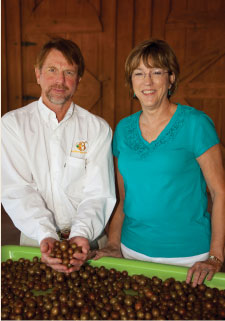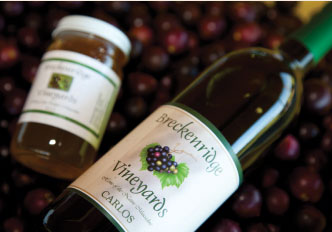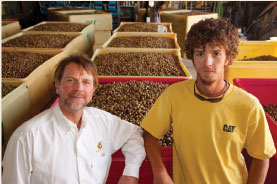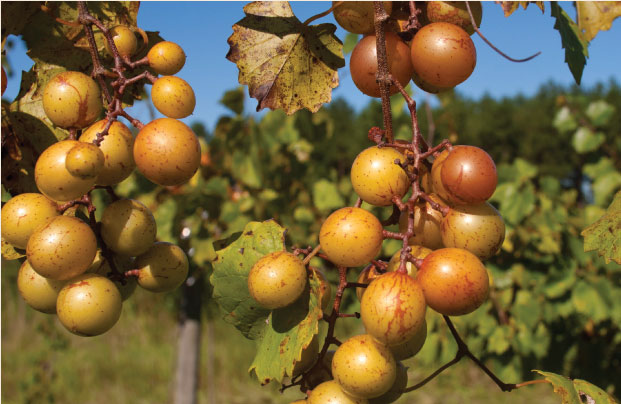Charley Phillips knows a good business opportunity when he sees it.
The Meridian, Miss., real estate investor has bought and sold timberland all his life and has developed corporate retreats at quail plantations and a 10,000-acre island near Memphis.

Charley and Alana Phillips grow a dozen varieties of muscadine grapes at Breckenridge Farms.
But several years ago he decided to slow down and enjoy his own land.
“I spent 15 years flying around on a jet and doing all the corporate stuff,” Charley says. “I decided to come home and be a farmer.”
Charley had been living on a poultry farm southwest of Meridian with his wife, Alana, and their children when he saw another opportunity he couldn’t pass up: The family bought one of the largest muscadine vineyards in the world.
Going Native
Muscadines thrive from East Texas to Virginia and as far north as southern Missouri. Many Southerners spend all year anticipating the few short weeks in late summer when they can capture the native fruit’s sweet, musky flavor in jellies, juices, wines and pies.
The grapes have been cultivated for centuries in the region, but it wasn’t until recent decades that they were grown on a large commercial scale. A pioneer in the field was Paul Broadhead, a mall developer and co-founder of the Cinemark theater chain, who began to look at muscadines as an alternative crop for growers struggling with the farm crisis in the 1980s.
About 35 miles south of Meridian, Broadhead planted 317 acres with several varieties of muscadines, establishing a vineyard and production facility for a new venture that produced juice, jams, syrups and other muscadine products. He also collaborated with Mississippi State University to explore cultivars that could be used for the juice market.
Charley first encountered the vast, state-of-the-art vineyard in 1987 when he started managing Broadhead’s real estate division.

The grapes at the vineyard were grown specifically for the juice market, but the products had trouble competing for space in grocery stores in the early days, especially outside the South, where consumers weren’t familiar with muscadines, Charley says.
“He was such a visionary and an entrepreneur,” Charley says of the late Broadhead. “He was probably 10 years ahead of his time.”
With juicing becoming less practical, the grapes were sold directly to wineries. After a few decades, the vigorous plants in the experimental vineyard had become overgrown, and the property went on the market. Knowing its potential, Charley and Alana bought the farm in 2003 and set out to make it their home and a more productive operation.
Growing in New Directions
Row upon row of muscadine vines cover trellises on about a quarter of the 925-acre property near Quitman, Miss., interspersed with ponds, hay fields, pines and a pecan grove.
The family renamed the vineyard Breckenridge Farms and moved into a a Western red cedar barndominium on the property. But though Charley had managed the vineyard as a business in the past, he was new to growing the grapes.
With the help of about a dozen workers, the whole family soon got involved in producing the muscadines, which come in bronze and purple varieties, some best for wine or juice and some best for eating fresh. In all, more than a dozen cultivars grow at Breckenridge Farms.
Alana, who had recently retired from teaching, began making and selling muscadine jelly and managing the sale of the fresh grapes to area grocery stores and directly to the public at the vineyard. The first to be harvested, the varieties for the fresh market are hand-picked in late summer as soon as they reach the desired sugar content, then are sold by the pound and in 10- and 20-pound boxes.
Word of mouth and some well-placed signs along the roads in Clarke County draw so many shoppers and tourists that Breckenridge Farms has sold as many as 7 tons of fresh grapes in a year. Some groups even call ahead and ask to ride their horses or motorcycles through the fragrant rows during harvest season, which runs for three to five weeks starting in late August.
“I’ve borrowed a lot of money in my life from local banks. I have a shoebox full of promissory notes I’ve paid off, so many that my wife tells me, ‘Dad-gum, you must have borrowed money to buy shoes.’”— Charley Phillips
Wine grapes are picked next, using mechanical harvesters fitted with fiberglass rods that knock individual grapes free as they pass through the vines.
“Some people say they tickle the grapes off the vines,” says Elliott, the Phillipses’ youngest child, who studied forestry in college and returned home to become the vineyard manager in 2009. Now 24, he lives in the barndominium — also known as a barndo — with his wife, Kristen, a dental hygienist.
The loose grapes are collected and shipped off for pressing. Some go to wineries in Mississippi and Louisiana. But most are pressed in the Florida Panhandle, and the juice is trucked to Rose Hill, N.C., where it goes into all 335,000 cases of muscadine wine produced each year at Duplin Winery, the state’s oldest operating winery.
With 225 acres of vines and a contract to produce 900 tons of fruit, Breckenridge Farms dwarfs the winery’s other growers, who typically have vineyards of less than 15 acres. But muscadines are an increasingly popular crop, and many North Carolina farmers have turned from tobacco to the grapes.
“It’s almost like an insurance policy,” Charley says of the competition. The advantage to having growers in the Gulf Coast and in North Carolina, he says, is that storms might hit one region or the other, but usually not both.
Knowing Which Way the Wind Is Blowing
The Phillipses well know the force of the weather. In 2005, two years after they bought the vineyard, Hurricane Katrina ripped through Louisiana and Mississippi just 10 days before they were set to harvest. With the fruit heavy on the vines, row after row of T-shaped trellises broke in the high winds.
“Those rows were like dominoes,” Charley says. “When this post broke, it fell on the next row, and it broke.”
“When Ivan came through the year before, the wind blew fruit on the ground,” Alana says. “But with Katrina, it just blew it away.”
It took the family a day and a half to make their way through downed trees and power lines to the vineyard. They lost 60 percent of their crop, but 200 acres of pines that they had planted in low-lying areas their first year acted as a windbreak and limited the damage.
They replaced many vines and hundreds of trellis posts after Katrina, and have continued to reclaim the aging vineyard. Last year alone they planted 12,000 vines, Charley says, and they have drastically pruned old vines to encourage new growth. The plan is to reinvigorate old vines or plant new ones on 20 percent of the vineyard in the next few years so that they can produce 1,000 to 1,200 tons of grapes, including more fresh varieties.
“It’s feasible we could produce 1,500 tons, but if we produce that, we’d need to go into other markets,” Charley says.
He would like to introduce more wineries to the unique flavor of muscadines, which can be used not just in the traditional Southern-style sweet wines but also in dry wines. He’s researching wineries in Louisiana and in Texas, the nation’s No. 6 wine producer.
Since they bought the vineyard, a new market for muscadines has already opened up. In the past, pomace — the pulp, thick skins and large seeds left over after the grapes are pressed — was considered a waste product. But muscadine seeds and skins have been found to have extremely high amounts of antioxidants, and the pomace is now a valuable commodity.
Muscadine extracts from the vineyard’s grapes are used in products from Nature’s Pearl of Advance, N.C., and Chaé Organics of La Veta, Colo. The market for nutraceuticals, such as nutritional supplements and skin care products, has added 20 percent to the vineyard’s bottom line since 2009.
That was the same year that Charley and Alana moved into their new plantation-style home at the vineyard.
Inspired by their experiences after Katrina, they designed their house with a generator, a safe room, reinforced roof framing and thick walls with spray-foam insulation. Built to protect them in an emergency, it’s already paying off: The monthly electric bill for the 5,500-square-foot house has never been higher than $300 and it is often closer to $100, they say.
New Financing With an Old Partner
After owning the vineyard for eight years, this summer the Phillipses decided the time was right to lock in to lower interest rates. For that they turned to Southern AgCredit, a lender they first used in 1994.
“I’ve borrowed a lot of money in my life from local banks,” Charley says. “I have a shoebox full of promissory notes I’ve paid off, so many that my wife tells me, ’Dad-gum, you must have borrowed money to buy shoes.’”

Charley Phillips handed over the day-to-day operation of the vineyard to his son Elliott, right, three years ago.
But Southern AgCredit has offered service unlike any other bank, they say. Their first loan officer, Glen Sowell, now a regional vice president at the corporate office in Ridgeland, Miss., would meet them after hours at their convenience. He once closed a loan at their son’s baseball game, signing papers on the hood of his pickup.
“Whatever it took, they’d accommodate you,” Charley says of Southern AgCredit. “I’d never seen a banker do that.”
He also likes the way the lender does its own timber appraisals. So when he approached Southern AgCredit recently about refinancing some of his timberland, it made sense to look at the vineyard, too.
“We have a good relationship with our local banker, but Southern AgCredit offered me some fixed-rate financing,” he says. “It would be foolish not to consider it.”
“He wanted to be able to get something locked in for a longer term, and we had the capability to do what he needed to do,” says John Ishee, assistant vice president and branch manager at the office in Newton. The loan closed in late October.
Now with a comfortable home and new financing for Breckenridge Farms in place, the Phillipses can concentrate on business. Besides the vineyard, they own 2,500 acres of timberland and a gravel pit that has been busy supplying roads to new oil-drilling sites in the area. And Kristen runs one boutique in Quitman and just opened a second with Alana in Ellisville, where Breckenridge Farms’ jellies and juice share space with clothing and accessories.
“We all just kind of work together,” Charley says. “We’re trying to stay home in the country and make a living.”
– Staff
Big Health Benefits in a Small Package
The first grape ever cultivated in the United States has a long history, but its future looks even more interesting.
Muscadines thrive in the hot, humid climate of the southeastern U.S., where wild grapes that grew in astonishing abundance were documented by Italian and English explorers in the 16th century. One plant known as the “Mother Vine” is believed to be the nation’s oldest cultivated grapevine. It has been growing for as long as 400 years on North Carolina’s Roanoke Island, possibly planted by Croatan Indians or early English colonists, and is the parent plant of vines that were propagated in the 17th and 18th centuries around the town of Scuppernong. The bronze variety took the town’s name and is now North Carolina’s state fruit.
Any native plant hardy enough to live that long has to have some special qualities.
Muscadines, Vitis rotundifolia, differ in some significant ways from European grapes, Vitis vinifera. The fragrant muscadines grow in small clusters of large fruit and have thicker skins and larger seeds than European grapes. They also have two more chromosomes, and the extra genetic material is believed to carry the code that gives the plants natural defenses against pests, diseases, fungi and sun damage. Muscadines also might pass along protective properties to the people and animals who consume the fruit.
Available in bronze and dark-skinned varieties, muscadines contain many times more phytochemicals than other grapes, such as resveratrol, ellagic acid, gallic acid and quercetin, which might play a role in lowering cholesterol and blood pressure. Recent research at Wake Forest University found that extracts from muscadine skins and seeds inhibit the growth of seven kinds of cancer cells in the laboratory, and other studies have shown that drinking muscadine wine boosts lymphocytes that fight cancer in the body. Resveratrol appears to have anti-aging properties, and the compound helped obese mice live longer, more active lives in a 2006 Harvard study.
Much has been written about the health benefits of red wine, but drinking wine isn’t the only way to take advantage of the compounds in muscadines. You can boost your consumption of antioxidants with a slice of muscadine pie, a glass of juice or a serving of jelly. To make it even easier for consumers, manufacturers are putting muscadine extracts in nutritional supplements and skin care products designed to pass along the benefits of this remarkable American original.
